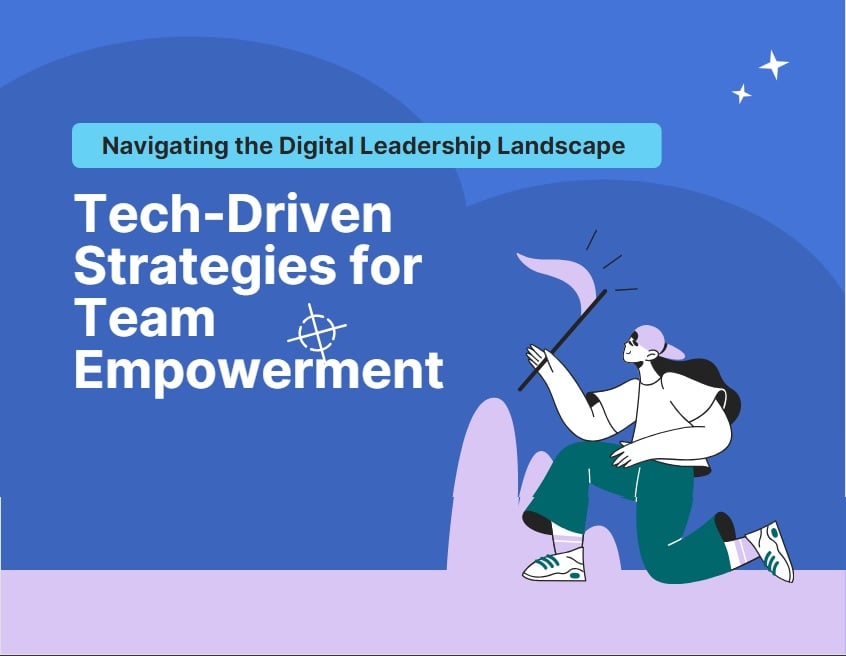Navigating the Digital Leadership Landscape: Tech-Driven Strategies for Team Empowerment
Effective digital leadership is increasingly intertwined with technology in the ever-evolving landscape of business. As organizations embrace digital transformation, leaders are presented with a wealth of opportunities to enhance team collaboration, communication, and overall productivity. This article explores the dynamic intersection of leadership and technology, unveiling strategies that empower teams to thrive in the digital age.
Table of Contents
What is digital leadership?
– Digital leadership is the ability to use digital technologies and platforms to achieve organizational goals and create positive change
– Digital leaders are not only proficient in using digital tools, but also in fostering a culture of innovation, collaboration and learning among their teams and stakeholders
– It requires a combination of technical, interpersonal and strategic skills, such as:
– Data literacy: the ability to collect, analyze and communicate data effectively
– Digital communication: the ability to use various digital channels and formats to engage and influence diverse audiences
– It requires the ability to design and implement digital solutions that improve processes, products and services
– Digital ethics: the ability to act responsibly and ethically in the digital space, respecting privacy, security and diversity
What is the vision of digital leadership?
The vision of digital leadership landscape is to leverage the power of technology to transform organizations, empower people, and create value. Digital leaders are not only adept at using digital tools, but also at fostering a culture of innovation, collaboration, and learning. They are able to align their strategies with the changing needs and expectations of their customers, employees, and stakeholders. Digital leaders are visionaries who can inspire others to embrace change and pursue excellence.
Leveraging Project Management Software for Seamless Collaboration
In the digital realm, project management software stands as a linchpin for leaders seeking to streamline workflows and boost team efficiency. Platforms like Asana, Trello, and Jira offer intuitive interfaces that enable leaders to assign tasks, set deadlines, and monitor progress in real-time. This fosters accountability and provides team members with a clear roadmap for success.
When wielded effectively, project management tools become a team’s digital backbone. Leaders can allocate resources efficiently, track project milestones, and identify potential bottlenecks before they impede progress. The result is a more agile and responsive team that can adapt swiftly to changing project dynamics.
In-House Tech Development for a Better Leadership Environment
While off-the-shelf technologies offer substantial advantages, leaders should consider the benefits of in-house tech development tailored to their needs. Creating custom solutions allows organizations to address unique challenges and foster a better leadership environment.
Tailored Project Management Systems
In-house development of project management systems can provide a tailored approach to address a team’s unique needs and workflows. Customization allows leaders to incorporate specific features and functionalities that align with the organization’s goals, ensuring a seamless and intuitive user experience. Outsourcing development projects to create in-house tech can be a valuable way to build effective collaboration programs for your company. Magento development companies are often used to help build project management systems for companies looking to grow their own tech arsenal.
Collaboration Tools Aligned with Organizational Culture for Digital Leadership
Custom-built collaboration tools can be designed to align with the organization’s culture and communication preferences. This ensures that the technology facilitates collaboration and reinforces the values and communication styles that define the team.
Strategic AI Implementation
Organizations can develop AI applications that align with their strategic objectives instead of relying solely on pre-built AI solutions. Whether it’s predictive analytics for market trends or personalized insights for decision-making, in-house AI development allows for a more targeted and strategic approach.
Adaptable Automation Solutions
In-house automation solutions can be crafted to address specific processes unique to the organization. This level of customization ensures that automation aligns seamlessly with existing workflows, reducing resistance to change and maximizing the benefits of streamlined processes in digital leadership landscape.
Encouraging a Culture of Innovation
Beyond the immediate benefits of in-house tech development, the process itself fosters a culture of innovation within the organization. Team members involved in development projects are empowered to think creatively, solve complex problems, and contribute to the continuous improvement of technology within the company.
Virtual Collaboration Tools for Digital Leadership: Breaking Down Geographical Barriers
In an increasingly prevalent era of remote work, virtual collaboration tools have become indispensable for leaders navigating geographically dispersed teams. Platforms such as Slack, Microsoft Teams, and Zoom facilitate seamless communication and collaboration, transcending physical boundaries.
These tools enable real-time communication and provide spaces for spontaneous ideation and creative exchange. Leaders can initiate virtual meetings, brainstorming sessions, and collaborative document editing, fostering a sense of unity among team members regardless of their physical location.
Moreover, virtual collaboration tools promote inclusivity by ensuring that every team member has a voice. Features like chat, video conferencing, and shared documents create a virtual office environment where ideas flow freely, and collective problem-solving becomes the norm.
Embracing Emerging Technologies: AI and Automation
As we peer into the future of effective digital leadership, artificial intelligence (AI) and automation emerge as transformative forces. Leaders can harness the power of AI to analyze vast datasets, derive meaningful insights, and make informed decisions. Machine learning algorithms can predict trends, identify potential risks, and optimize processes, allowing leaders to navigate their teams with a data-driven compass.
Conversely, automation liberates teams from repetitive tasks, allowing them to focus on more strategic and creative endeavors. Leaders can automate routine workflows, reducing the risk of errors and enhancing overall efficiency. This accelerates project timelines and frees up valuable human resources for tasks that demand critical thinking and innovation.
Challenges of Leading Without Proper Tech Support
While the benefits of integrating technology into effective digital leadership strategies are clear, it’s crucial to acknowledge the challenges that arise when leading a team without proper tech support. In a rapidly digitizing world, teams without access to advanced tools may face communication, collaboration, and adaptability hurdles, making leadership much more difficult.
Limited Collaboration and Communication
Without virtual collaboration tools, teams may struggle with communication, especially if members are geographically dispersed. The absence of instant messaging, video conferencing, and shared document platforms can lead to delays, misunderstandings, and a lack of cohesion among team members.
Inefficiencies in Workflow Management

Project management software is not just a luxury but a necessity for teams aiming to maximize efficiency. Without these tools, leaders may find it challenging to allocate resources effectively, track progress, and identify potential issues in the workflow. This lack of visibility can hinder the team’s ability to meet deadlines and deliver quality results.
Missed Opportunities for Innovation
Emerging technologies such as AI and automation are about efficiency and innovation. Teams without access to these technologies may struggle to stay competitive, missing out on opportunities to streamline processes, uncover insights, and drive transformative changes within their respective industries.
Resistance to Change
A team lacking exposure to modern technologies may resist change when presented with new tools. Overcoming this resistance requires not only the introduction of technology but also effective change management strategies to ensure a smooth transition and adoption by team members.
Cultivating a Tech-Forward Mindset within the Team for Digital Leadership
Beyond the adoption of specific tools, effective leaders in the digital age cultivate a tech-forward mindset within their teams. This involves fostering a culture of continuous learning, where team members are encouraged to explore and master new technologies relevant to their roles.
Leaders can organize training sessions or workshops and provide access to online resources to keep their teams abreast of the latest technological developments. This not only enhances individual skill sets but also contributes to the overall agility and adaptability of the team in the face of technological evolution.
Encouraging experimentation is another key facet of cultivating a tech-forward mindset. Leaders should create an environment where team members feel empowered to test and implement new tools or processes. This sparks innovation and positions the team as early adopters, gaining a competitive edge in a rapidly changing business landscape.
In the digital leadership landscape, success is not merely about adopting technology for its own sake but harnessing its power to elevate the capabilities of the team. Leaders who adeptly integrate project management software, virtual collaboration tools, and emerging technologies like AI and automation empower their teams to thrive in an era of constant change. As we navigate the digital frontier, the synergy between leadership and technology emerges as the catalyst for innovation, collaboration, and sustained success.
Irwin Michael Reston is an expert who has more than 30 years of experience in optimizing businesses, inspiring individuals and improving human resources departments. He established the BlueLight Consulting Limited to provide learning and training service worldwide.











